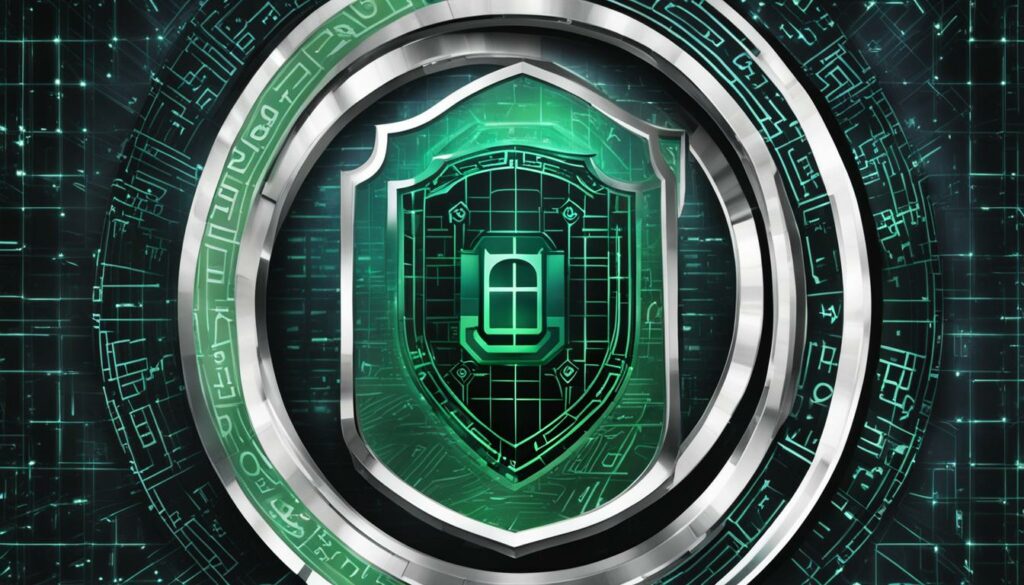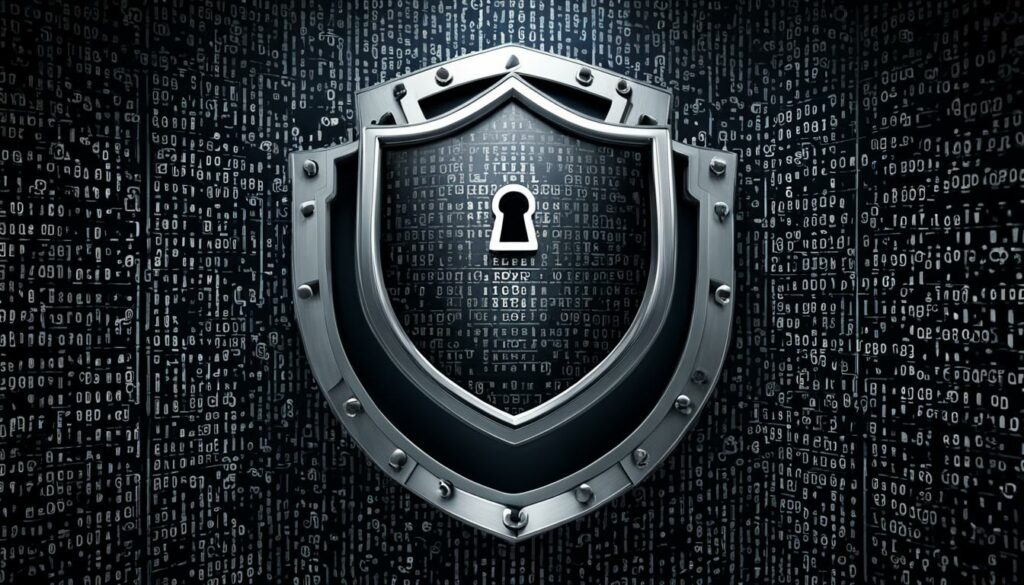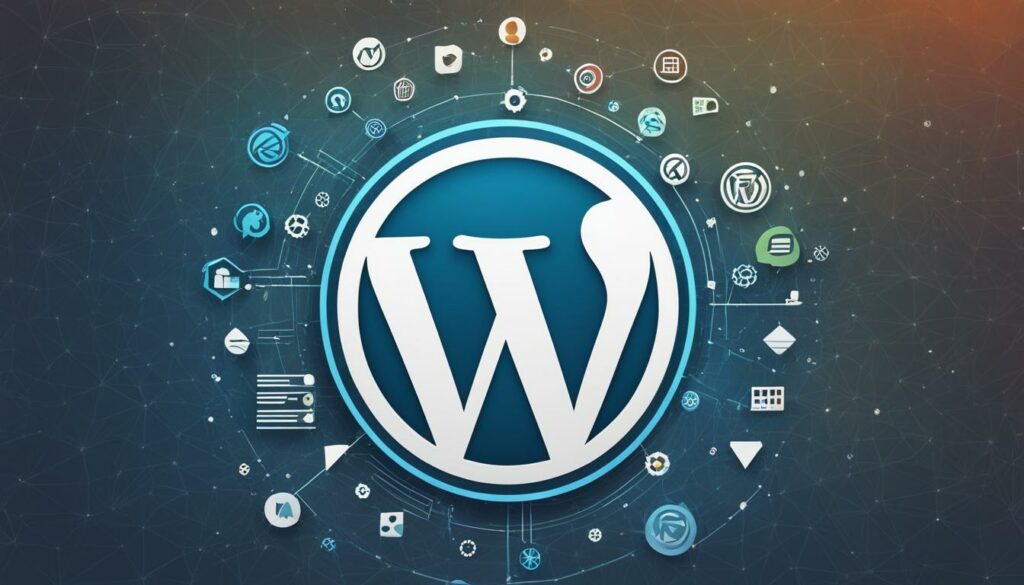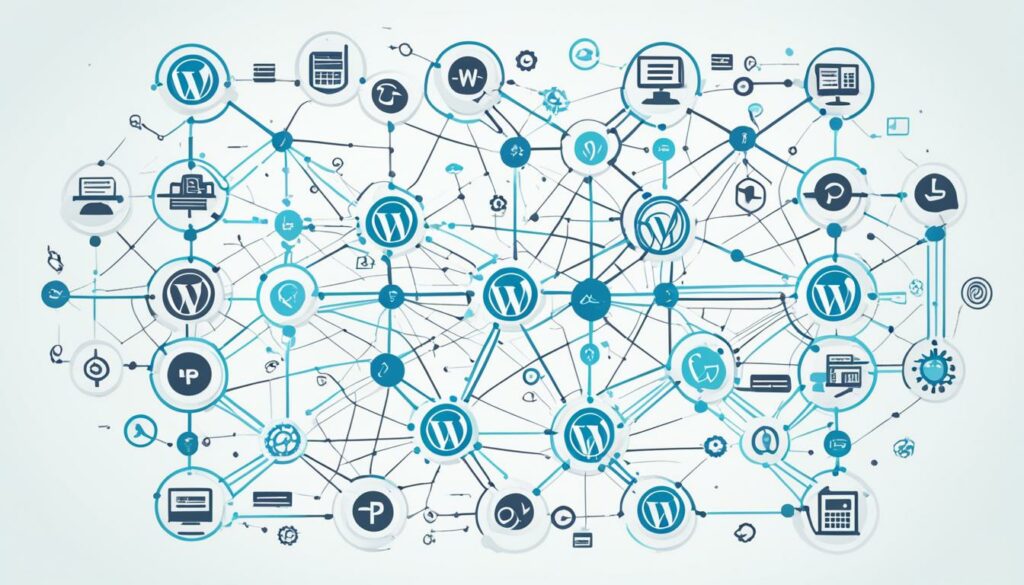When it comes to managing a WordPress website, data security should be a top priority. With the increasing number of cyber threats and the potential consequences of a breach, it’s essential to take proactive measures to protect your website and the sensitive information it holds. In this guide, we will explore the best practices for ensuring data security in WordPress hosting, offering you peace of mind and confidence in the safety of your online presence.
At BoostedHost, we understand the importance of secure web hosting and the role it plays in safeguarding your data. That’s why we recommend our WordPress Hosting solution for optimal performance and maximum security. With BoostedHost, you can rest assured knowing that your website is hosted on a secure and reliable platform, backed by advanced security measures and cutting-edge technology.
Key Takeaways:
- Choose a reputable hosting provider like BoostedHost for secure web hosting.
- Maintain regular updates for WordPress core software, themes, and plugins to mitigate vulnerabilities.
- Create strong passwords and use unique usernames to strengthen login security.
- Implement additional security measures such as two-factor authentication and captcha.
- Regularly scan your WordPress site for malware and vulnerabilities.
By following these best practices, you can ensure the highest level of data security and protect your website from potential threats. Sign up for BoostedHost’s WordPress Hosting today through this link: www.boostedhost.com/wordpress-hosting and take advantage of our secure hosting solutions.
Why WordPress Security is Important
WordPress security is vital for website owners like yourself. With the prevalence of website attacks and the potential risks they pose, protecting your WordPress site is essential. Hackers can exploit vulnerabilities, compromising user information and installing malware that can have devastating consequences. However, WordPress security isn’t just about eliminating risks; it’s also about reducing them. As a website owner, you have the power to take action and improve the security of your WordPress site, safeguarding it from potential threats.
One of the key aspects of WordPress security is risk reduction. By implementing security measures and following best practices, you can significantly minimize the chances of your site being compromised. This includes keeping your WordPress core software updated, utilizing strong passwords, and taking advantage of security plugins.
Furthermore, WordPress security aims to eliminate vulnerabilities that can leave your site susceptible to attacks. Regular updates to the WordPress core provide patches and fixes to address security flaws, reducing the risk of unauthorized access or malicious activities. Strong authentication practices, such as implementing two-factor authentication, can also help prevent unauthorized entry.
By focusing on WordPress security, you can ensure the safety and integrity of your website, protecting both yourself and your visitors from potential harm. It is an ongoing effort that requires vigilance and implementation of the latest security practices.
Basics of WordPress Security
WordPress is equipped with a highly secure core software that undergoes regular maintenance and auditing by developers. However, to ensure maximum protection for your website, it is essential to implement additional security practices. In this section, we will explore the basics of WordPress security, focusing on two key factors: keeping WordPress updated and using strong passwords.
The Importance of Keeping WordPress Updated
Regular updates play a crucial role in maintaining the security of your WordPress website. The core software updates released by the WordPress team are designed to address any vulnerabilities and strengthen the overall security of the platform. By keeping your WordPress installation up to date, you ensure that your site benefits from the latest security enhancements.
Updating WordPress is a straightforward process. Simply log in to your WordPress dashboard, navigate to the Updates section, and follow the prompts to install the latest version. It is also recommended to update themes and plugins regularly, as outdated versions may contain security vulnerabilities that can be exploited by malicious actors.
Using Strong Passwords for Enhanced Security
Your choice of passwords plays a critical role in safeguarding your WordPress site against unauthorized access. Weak or easily guessable passwords increase the risk of a security breach. To protect your website, it is crucial to use strong, unique passwords for all user accounts, including the administrator account.
Tip: When creating strong passwords, consider using a combination of uppercase and lowercase letters, numbers, and special characters. Avoid using easily guessable information such as your name, birthdate, or common words.
Additionally, it is highly recommended to change your passwords regularly. By updating your passwords periodically, you minimize the risk of unauthorized access even if a password is compromised.
Implementing these basic security practices will significantly enhance the protection of your WordPress website and mitigate potential security vulnerabilities.
Table: Key Security Practices for WordPress
| Security Practice | Description |
|---|---|
| 1. Keep WordPress Updated | Regularly update WordPress core software, themes, and plugins to benefit from the latest security patches and enhancements. |
| 2. Use Strong Passwords | Create and regularly update strong passwords to protect user accounts and prevent unauthorized access. |
| 3. Enable Two-Factor Authentication | Add an extra layer of security by requiring users to provide a second form of verification when loggining in. |
| 4. Install Security Plugins | Utilize reputable security plugins to enhance your site’s defense against common threats and vulnerabilities. |
| 5. Regularly Back Up Your Website | Perform regular backups of your website to ensure you can restore your site in the event of a security breach or data loss. |
Implementing these security practices will significantly reduce the risk of website vulnerabilities and protect your WordPress site from potential threats.
The Role of Web Hosting
When it comes to WordPress security, your choice of web hosting service can make all the difference. A reliable and secure hosting provider is essential to protect your website from common threats and ensure the safety of your valuable data. In this section, we will explore how web hosting plays a crucial role in enhancing WordPress security and provide you with important considerations for selecting the right hosting service.
One of the key factors to consider is the type of hosting plan you opt for. Shared hosting, although cost-effective, carries a higher risk of cross-site contamination. This means that if a website sharing the same server as yours gets compromised, it can potentially impact your site’s security as well. On the other hand, managed WordPress hosting offers a more secure platform specifically optimized for WordPress websites. With managed hosting, your site operates in a controlled environment, minimizing the risk of security breaches.
Additionally, reputable hosting providers implement robust security measures to protect their servers from common threats like Distributed Denial-of-Service (DDoS) attacks. These measures ensure that your website remains safe and accessible to your visitors even during peak traffic times.
Moreover, managed WordPress hosting services often provide additional features such as regular backups, automatic updates, and proactive security monitoring. These features relieve you from the responsibility of manually maintaining your site’s security and ensure that your WordPress version, themes, and plugins are always up to date.
BoostedHost: Your WordPress Hosting Solution
When it comes to reliable WordPress hosting that prioritizes security, we recommend BoostedHost. With their optimized servers and advanced security measures, you can trust BoostedHost to keep your website safe and secure.
Comparing Shared Hosting and Managed WordPress Hosting
| Hosting Type | Shared Hosting | Managed WordPress Hosting |
|---|---|---|
| Security | Higher risk of cross-site contamination | More secure platform specifically optimized for WordPress websites |
| Server Resources | Shared resources with other websites on the same server | Dedicated resources for your WordPress site |
| Server Maintenance | Manual updates and maintenance required | Automatic updates and proactive security monitoring |
| Support | Basic technical support | WordPress-specific support and expertise |
As you can see, managed WordPress hosting offers a more secure and hassle-free hosting environment for your WordPress site. It provides dedicated server resources, automatic updates, proactive security monitoring, and specialized support.
Take the necessary steps to prioritize your website’s security by choosing a reputable WordPress hosting service like BoostedHost. Sign up now through this link to ensure your website’s optimal performance and security.
WordPress Security in Easy Steps (No Coding)
Securing your WordPress website doesn’t have to be complicated or require extensive coding knowledge. By following a few simple steps, you can significantly enhance the security of your site and protect it from potential threats.
1. Backup Your Website Regularly
Creating regular backups of your website is an essential security measure. In the event of a security breach or data loss, you can easily restore your site to a previous working state. Consider using a reliable backup solution like UpdraftPlus or BackupBuddy.
2. Install a Security Plugin
Security plugins provide an extra layer of protection for your WordPress site. They can help detect and prevent malicious activities, such as malware injections and brute-force attacks. Some popular security plugins include Wordfence and Sucuri Security.
3. Enable a Web Application Firewall
A web application firewall (WAF) acts as a shield between your website and potential threats. It filters out malicious traffic, blocks suspicious requests, and provides an additional layer of defense. Cloudflare and Sucuri provide reliable WAF solutions.
4. Move to SSL/HTTPS
Securing your website with SSL/HTTPS encryption not only protects your users’ data but also boosts your site’s credibility. Install an SSL certificate and configure your WordPress site to use HTTPS. Let’s Encrypt offers free SSL certificates.
5. Implement Secure Login Measures
Protecting your login page is crucial to prevent unauthorized access. Use strong passwords for your admin accounts and encourage users to do the same. Additionally, consider implementing two-factor authentication for an extra layer of security.
Remember, securing your WordPress website starts with taking the necessary security measures. By implementing these steps, you can significantly enhance the security of your site and ensure the protection of your data.
| Step | Description |
|---|---|
| 1 | Create regular backups of your website using a reliable backup solution. |
| 2 | Install a security plugin to add an extra layer of protection to your WordPress site. |
| 3 | Enable a web application firewall (WAF) to filter out malicious traffic. |
| 4 | Move to SSL/HTTPS to secure your website and boost credibility. |
| 5 | Implement secure login measures, such as using strong passwords and enabling two-factor authentication. |
Scanning WordPress for Malware and Vulnerabilities
Regularly scanning your WordPress site for malware and vulnerabilities is crucial to maintaining security and protecting your website from potential threats. By identifying and addressing any malicious activity or weaknesses, you can ensure the integrity and safety of your site.
There are several effective plugins and tools available that can help you scan and detect malware and vulnerabilities in your WordPress installation. These tools analyze your website files, database, and code to identify any potential risks.
One highly recommended plugin for malware scanning is Wordfence. It offers comprehensive scanning functionality, including a powerful threat intelligence network that constantly updates its database to identify new malware strains. Wordfence also provides a firewall to block suspicious traffic and prevents unauthorized access to your site.
Another popular option is Sucuri, which offers both malware scanning and vulnerability scanning. Sucuri’s scanning features can help identify malware infections, blacklisting status, website errors, and outdated software versions. It also provides recommendations for improving your website’s security.
When performing a malware scan, it’s essential to follow these best practices:
- Run regular malware scans: Schedule periodic scans to ensure that your site remains protected against emerging threats. Consider scanning your site at least once a week or after making significant changes.
- Scan all files and directories: Perform a comprehensive scan of all files and directories on your website, including themes, plugins, and uploaded media files.
- Check for outdated software: Make sure all WordPress core files, themes, and plugins are up to date. Outdated software can contain vulnerabilities that hackers can exploit.
- Review scan results: Analyze the scan results carefully to identify any malware infections or vulnerabilities. Take necessary actions to remove malware and fix vulnerabilities promptly.
- Implement security recommendations: If the scanning tool provides recommendations for improving your site’s security, follow them to enhance your WordPress security posture.
Example:
“Regular scanning of your WordPress site for malware and vulnerabilities is like conducting routine health check-ups. It allows you to catch and address potential issues before they cause significant harm to your website and its reputation.” – Jane Morrison, Security Analyst at BoostedHost
By regularly scanning your WordPress site for malware and vulnerabilities, you can stay one step ahead of potential threats and ensure the security of your website. Remember to choose a reliable scanning tool, review scan results diligently, and take prompt action to address any issues identified.
Fixing a Hacked WordPress Site
Discovering that your WordPress site has been hacked can be devastating. Not only is your website’s security compromised, but it can also result in the loss of valuable data and damage to your online reputation. When faced with a hacked WordPress site, it is crucial to act swiftly and take the necessary steps to regain control and restore security.
Identifying the Source of the Hack
The first step in fixing a hacked WordPress site is to identify the source of the hack. By understanding how the hack occurred, you can take appropriate measures to prevent future security breaches. Some common sources of hacks include outdated plugins or themes, weak passwords, insecure hosting environments, or vulnerabilities in the WordPress core software itself.
Start by thoroughly analyzing your website logs and any available security reports. Look for suspicious activities, unauthorized access, or any unexplained modifications to your files or database. If necessary, consult with a professional website security service to conduct a comprehensive malware scan.
Removing Malware
Once you have identified the source of the hack, the next step is to remove the malware from your WordPress site. Malware can be hidden in various files and directories, making it essential to perform a thorough cleanup.
Begin by taking a complete backup of your website, including the database and all files. This backup will serve as a safety net in case anything goes wrong during the removal process. Next, disable any suspicious plugins or themes and delete them from your WordPress installation. Update all your remaining plugins and themes to their latest versions to patch any security vulnerabilities.
Use a reliable security plugin, such as Sucuri or Wordfence, to scan your website for malware and remove any infected files or code. These plugins can help you identify and quarantine malicious content, ensuring a clean and secure website.
Repairing the Damage
After removing the malware, it is essential to repair any damage caused by the hack. This includes restoring any modified or deleted files, cleaning up spammy or malicious content, and addressing any website functionality issues.
Refer to your backups to restore the modified or deleted files to their original state. Ensure that all your website’s functionality, including forms, contact information, and e-commerce capabilities, is working correctly. Update all passwords, including those for your WordPress admin account, FTP, and hosting panel, to prevent unauthorized access in the future.

Finally, implement additional security measures to prevent future hacks. Regularly update your WordPress core, themes, and plugins to their latest versions to ensure that you have the latest security patches. Install a web application firewall (WAF) to provide an extra layer of protection against malicious attacks. Consider utilizing a secure hosting environment with strong server-level security measures and robust backup capabilities.
In this digital age, website security is of utmost importance. Don’t wait until your WordPress site gets hacked. Take proactive steps to protect your website and ensure the safety of your valuable data. Remember, prevention is always better than cure.
Keeping Themes, Plugins, and WordPress Version Up to Date
Ensuring the security of your WordPress site is of utmost importance, and a key aspect of this is keeping your themes, plugins, and WordPress version up to date. Developers regularly release updates to address security vulnerabilities and improve the stability of their software. By regularly updating these components, you can enhance the security of your site and protect it from potential risks.
Updating themes, plugins, and the WordPress core is a simple yet effective way to safeguard your website. When developers discover security vulnerabilities, they quickly release updates to patch any weaknesses. Applying these updates promptly ensures that your site is protected against known vulnerabilities and reduces the risk of it being compromised.
Outdated themes, plugins, and WordPress versions are common targets for hackers, as they often have known security vulnerabilities. By keeping everything up to date, you minimize the chances of your site falling victim to these security threats. It’s crucial to stay proactive and install updates as soon as they become available.
Remember, the responsibility for updating themes, plugins, and the WordPress version lies with the website owner. It’s essential to regularly check for updates and apply them promptly to maintain the security of your site.
How to Update Themes, Plugins, and WordPress Version
- Login to your WordPress admin dashboard.
- Click on the “Updates” option in the sidebar menu.
- On the updates page, you will see available updates for your themes, plugins, and WordPress core.
- Check the boxes next to the items you want to update.
- Click the “Update Themes,” “Update Plugins,” or “Update WordPress” button to initiate the updates.
- Wait for the updates to complete.
- After the updates are finished, make sure to check your site for any issues or conflicts that may have arisen.
By following these simple steps, you can easily keep your themes, plugins, and WordPress version up to date and ensure the security of your WordPress site. Don’t neglect this important aspect of WordPress security – frequent updates are your first line of defense against potential security vulnerabilities.
Applying Username and Password Best Practices
Keeping your WordPress site secure starts with using strong passwords and unique usernames. By following best practices for creating and managing passwords, you can prevent unauthorized access to your site. Additionally, user authentication and limiting access to the WordPress admin account are crucial for maintaining a secure environment.
Here are some tips to help you implement username and password best practices:
- Create Strong Passwords: Use a combination of uppercase and lowercase letters, numbers, and special characters. Avoid using easily guessable information, such as your name or birthdate. Remember to change your passwords regularly.
- Use Unique Usernames: Avoid using common usernames like “admin” or “user.” Choose a username that is difficult for hackers to guess.
- Consider a Password Manager: Password managers can generate and store strong, unique passwords for each of your online accounts, including your WordPress site. This helps you avoid the temptation of reusing passwords across multiple platforms.
- Implement User Authentication: Enable two-factor authentication (2FA) for your WordPress site. 2FA adds an extra layer of security by requiring a second form of verification, such as a temporary code sent to your mobile device, in addition to your username and password.
- Limit Access to the WordPress Admin Account: Only provide administrative access to trusted individuals who require it. Regularly review and update user roles and permissions to ensure proper access control.
“Using strong passwords and unique usernames is like having a sturdy lock and a secret key. It’s a crucial step towards keeping your WordPress site safe from unauthorized access.”
Remember, taking control of your username and password security is a fundamental step in protecting your WordPress site. By following these best practices, you can significantly reduce the risk of unauthorized access and maintain the integrity of your website.

You are now more equipped to secure your WordPress site than ever before! Use the table below to summarize the essential username and password best practices:
| Best Practices | Description |
|---|---|
| Create Strong Passwords | Use a combination of uppercase and lowercase letters, numbers, and special characters. Change passwords regularly. |
| Use Unique Usernames | Avoid common usernames like “admin.” Choose a username that is difficult to guess. |
| Consider a Password Manager | Generate and store strong, unique passwords for each account. Avoid reusing passwords. |
| Implement User Authentication | Enable two-factor authentication (2FA) for an additional layer of security. |
| Limit Access to Admin Account | Only provide administrative access to trusted individuals. Regularly review and update user roles and permissions. |
Limiting Login Attempts and Moving the WordPress Login URL
Protecting the login security of your WordPress site is crucial to prevent brute-force attacks and unauthorized access. In this section, we will explore two effective measures that can significantly enhance the security of your WordPress login: limiting login attempts and changing the WordPress login URL.
Limiting Login Attempts with Plugins
Brute-force attacks involve hackers attempting multiple login combinations to gain access to your WordPress site. By limiting the number of login attempts per user, you can thwart these malicious activities and protect your site from unauthorized access.
One way to implement this security measure is by using plugins like “Limit Login Attempts” or “WP Limit Login Attempts.” These plugins allow you to set a specific number of login attempts before users are locked out of the login page, preventing hackers from repeatedly trying different combinations.
Additionally, these plugins often provide features like IP blocking and email notifications to further enhance the security of your WordPress login.
Changing the WordPress Login URL
Another effective security measure is to change the default WordPress login URL. By default, the WordPress login page can be accessed through “/wp-login.php” or “/wp-admin/.” Hackers often target these well-known URLs to launch brute-force attacks.
To make it more difficult for hackers to find the login page, you can change the WordPress login URL to a custom address. This can be done by using plugins such as “WPS Hide Login” or through manual configuration in your website’s .htaccess file.
By customizing the login URL, you create an additional layer of protection, making it harder for hackers to locate and target your WordPress login page.
Implementing both measures—limiting login attempts and changing the login URL—provides a robust defense against brute-force attacks and significantly strengthens the security of your WordPress site.
Remember to regularly monitor your website’s security, keep your plugins and themes updated, and choose a secure hosting provider to further fortify your WordPress security.
Using Two-Factor Authentication and Adding Captcha to Forms
To enhance the security of your WordPress site and protect against unauthorized access, it’s crucial to implement two-factor authentication and add captcha to your forms. By requiring users to provide a second form of verification and confirming that they are human, you can significantly reduce the risk of automated attacks and ensure form security. Here’s how you can enable these security measures:
- Two-Factor Authentication:
- Install a two-factor authentication plugin like “Two-Factor” by WordPress.org or “Google Authenticator – Two Factor Authentication” by WordPress.org.
- Activate the plugin and configure the settings according to your preference.
- Table: Top Two-Factor Authentication Plugins
- Adding Captcha to Forms:
- Select a captcha plugin such as “reCAPTCHA” by WordPress.org.
- Install and activate the plugin.
- Obtain Google reCAPTCHA keys by signing up on the Google reCAPTCHA website.
- Configure the plugin settings, providing the obtained keys.
- Table: Top Captcha Plugins
To enable two-factor authentication on your WordPress site, follow these steps:
| Plugin Name | Downloads | Rating |
|---|---|---|
| Two-Factor | 100,000+ | 4.8/5 |
| Google Authenticator | 50,000+ | 4.7/5 |
To add captcha to your WordPress forms and prevent automated attacks, follow these steps:
| Plugin Name | Downloads | Rating |
|---|---|---|
| reCAPTCHA | 200,000+ | 4.9/5 |
| Really Simple CAPTCHA | 100,000+ | 4.7/5 |
Keep in mind that two-factor authentication and captcha work together to provide robust user verification and form security. By implementing these measures, you can significantly reduce the risk of unauthorized access and protect your WordPress site from potential attacks.

Conclusion
WordPress security is essential for protecting your website and ensuring the safety of your data. By implementing the best practices outlined in this guide, you can significantly enhance the security of your WordPress site and reduce the risk of hacks and vulnerabilities.
First and foremost, make sure to regularly update your WordPress installation. Keeping up with the latest software versions is crucial for staying protected against potential security flaws and vulnerabilities.
In addition, using strong passwords and unique usernames will help prevent unauthorized access to your site. Consider using a password manager to generate and store complex passwords securely.
Choosing a reliable and secure web hosting provider, such as BoostedHost, is another important step in safeguarding your website. BoostedHost offers WordPress Hosting that provides optimal performance and data security. Sign up now through this link: www.boostedhost.com/wordpress-hosting.
To further fortify your WordPress site, implementing additional security measures like two-factor authentication and captcha can significantly reduce the risk of unauthorized access and automated attacks.
Safeguarding your data and ensuring the security of your hosting environment is crucial for maintaining a successful online presence. By following these recommendations, you can protect your WordPress site, enhance data security in hosting, and provide a safe browsing experience for your users.
FAQ
Q: Why is WordPress security important?
A: WordPress security is important because website attacks are prevalent, and hackers can steal user information and install malware on compromised sites. By implementing security measures, you can reduce the risk of these attacks and protect your website.
Q: What are the basics of WordPress security?
A: The basics of WordPress security include keeping WordPress updated and using strong passwords. Regularly updating themes, plugins, and the WordPress version is also crucial for maintaining security.
Q: What role does web hosting play in WordPress security?
A: Web hosting providers play a crucial role in WordPress security. Good hosting providers have measures in place to protect their servers against common threats, such as DDOS attacks. Managed WordPress hosting offers more secure platforms compared to shared hosting plans.
Q: How can I enhance WordPress security without coding skills?
A: Enhancing WordPress security does not require coding skills. You can install a backup solution, use security plugins, enable a web application firewall, move to SSL/HTTPS, and implement secure login measures to enhance security.
Q: How can I scan WordPress for malware and vulnerabilities?
A: You can scan WordPress for malware and vulnerabilities using plugins and tools that are available. These tools can help you detect any malicious activity or vulnerabilities on your WordPress site.
Q: What should I do if my WordPress site gets hacked?
A: If your WordPress site gets hacked, you should identify the source of the hack, remove malware, and repair any damage caused by the attack. It is essential to act quickly to minimize the impact of the hack on your site.
Q: Why is keeping themes, plugins, and the WordPress version up to date important for security?
A: Keeping themes, plugins, and the WordPress version up to date is crucial for security because developers often release updates to address security vulnerabilities and improve the stability of their software.
Q: What are the best practices for usernames and passwords in WordPress?
A: Strong passwords and unique usernames are essential for preventing unauthorized access to your WordPress site. It is also recommended to use a password manager to create and manage secure passwords. User authentication and limiting access to the WordPress admin account are also important.
Q: How can I limit login attempts and change the WordPress login URL?
A: You can limit login attempts through plugins and change the login URL to protect against brute-force attacks. These security measures make it more difficult for hackers to gain unauthorized access to your WordPress site.
Q: How can I enable two-factor authentication and add captcha to WordPress forms?
A: Enabling two-factor authentication adds an extra layer of security by requiring users to provide a second form of verification. You can also add captcha to WordPress forms to verify that the user is a human and prevent automated attacks.
Q: How can I protect my WordPress site and ensure the security of my hosting environment?
A: By following best practices such as regularly updating WordPress, using strong passwords, choosing a secure web hosting provider, and implementing additional security measures such as two-factor authentication and captcha, you can significantly enhance the security of your WordPress site and protect your data.












